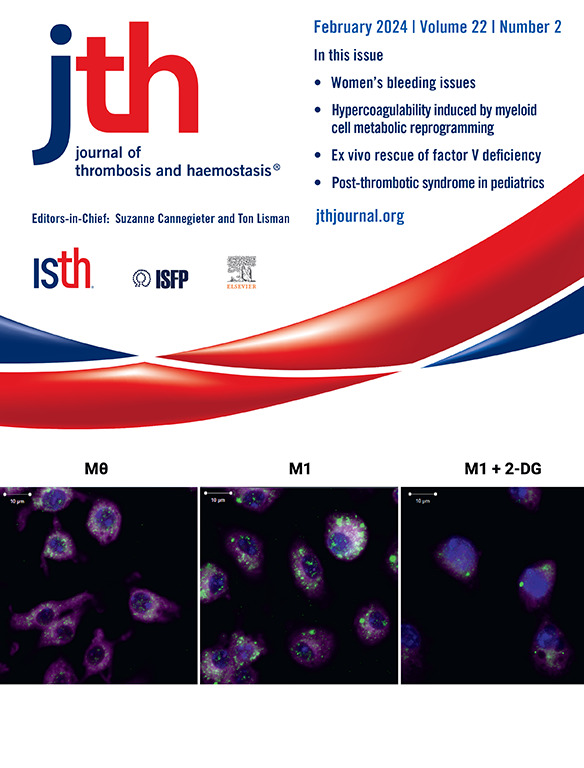Genetic study of von Willebrand factor antigen levels ≤ 50 IU/dL identifies variants associated with increased risk of von Willebrand disease and bleeding
IF 5
2区 医学
Q1 HEMATOLOGY
引用次数: 0
Abstract
Background
von Willebrand disease (VWD) is a common inherited bleeding disorder caused by low levels or activity of circulating von Willebrand factor (VWF). Genetic susceptibility to VWF antigen (VWF:Ag) below normal ( 50 IU/dL) in the general population is underexplored.
Objectives
To identify genetic variants influencing VWF:Ag levels 50 IU/dL.
Methods
We performed a genome-wide association study in 926 cases with VWF:Ag levels 50 IU/dL and 12 846 controls from 7 studies from the Trans-Omics for Precision Medicine program. We then examined whether significant genome-wide findings were also associated with clinical diagnosis of VWD in 5 biobanks with 708 VWD cases and 1 286 069 controls, and with 6 bleeding and thrombotic disorders in FinnGen.
Results
Variants at 2 loci were associated (P < 5 × 10−9) with VWF:Ag levels 50 IU/dL: ABO and VWF. The VWF index variant, p.Tyr1584Cys, is a rare (0.22%) missense variant with odds ratio (OR) of 78.58, while the ABO index variant is a common intronic variant with a smaller effect (OR = 2.52). Notably, both VWF (OR = 7.16) and ABO (OR = 1.57) variants were also associated (P < .025) with diagnosed VWD. Among p.Tyr1584Cys heterozygotes, the penetrance of VWF:Ag levels 50 IU/dL was 24.2% and the penetrance of diagnosed VWD was 0.3%. p.Tyr1584Cys was associated (P < .0042) with increased odds of heavy menstrual bleeding (OR = 1.27), iron deficiency anemia (OR = 1.55), and intrapartum hemorrhage (OR = 2.20), but decreased odds of deep vein thrombosis (OR = 0.54).
Conclusions
Although there are currently conflicting interpretations of pathogenicity p.Tyr1584Cys, our results suggest that it is a low penetrance pathogenic variant that contributes to VWF:Ag levels 50 IU/dL, bleeding, and VWD.
血管性血友病因子抗原水平≤50 IU/dL的遗传研究确定了与VWD和出血风险增加相关的变异。
背景:血管性血友病(VWD)是一种常见的遗传性出血性疾病,由循环血管性血友病因子(VWF)低水平或低活性引起。普通人群对VWF抗原(VWF:Ag)低于正常水平(≤50 IU/dL)的遗传易感性尚不清楚。方法:为了确定影响VWF:Ag水平≤50 IU/dL的遗传变异,我们对来自TOPMed项目的7项研究中的926例VWF:Ag水平≤50 IU/dL的病例和12,846例对照进行了全基因组关联研究。然后,我们在芬兰的5个生物银行(708例VWD病例和1,286,069例对照)以及6种出血和血栓性疾病中检查了全基因组显著性发现是否也与VWD的临床诊断相关。结果:两个位点的变异与VWF相关(P-9):Ag水平≤50 IU/dL: ABO和VWF。VWF指数变异p.Tyr1584Cys是一种罕见的(0.22%)错义变异,比值比(OR)为78.58,而ABO指数变异是一种常见的内含子变异,影响较小(OR=2.52)。值得注意的是,VWF (OR=7.16)和ABO (OR=1.57)变异也与VWF (OR=7.16)相关。结论:虽然p.t tyr1584cys目前对致病性有相互矛盾的解释,但我们的研究结果表明,它是一种低外显率的致病变异,有助于VWF:Ag水平≤50 IU/dL,出血和VWD。
本文章由计算机程序翻译,如有差异,请以英文原文为准。
求助全文
约1分钟内获得全文
求助全文
来源期刊
CiteScore
24.30
自引率
3.80%
发文量
321
审稿时长
1 months
期刊介绍:
The Journal of Thrombosis and Haemostasis (JTH) serves as the official journal of the International Society on Thrombosis and Haemostasis. It is dedicated to advancing science related to thrombosis, bleeding disorders, and vascular biology through the dissemination and exchange of information and ideas within the global research community.
Types of Publications:
The journal publishes a variety of content, including:
Original research reports
State-of-the-art reviews
Brief reports
Case reports
Invited commentaries on publications in the Journal
Forum articles
Correspondence
Announcements
Scope of Contributions:
Editors invite contributions from both fundamental and clinical domains. These include:
Basic manuscripts on blood coagulation and fibrinolysis
Studies on proteins and reactions related to thrombosis and haemostasis
Research on blood platelets and their interactions with other biological systems, such as the vessel wall, blood cells, and invading organisms
Clinical manuscripts covering various topics including venous thrombosis, arterial disease, hemophilia, bleeding disorders, and platelet diseases
Clinical manuscripts may encompass etiology, diagnostics, prognosis, prevention, and treatment strategies.

 求助内容:
求助内容: 应助结果提醒方式:
应助结果提醒方式:


